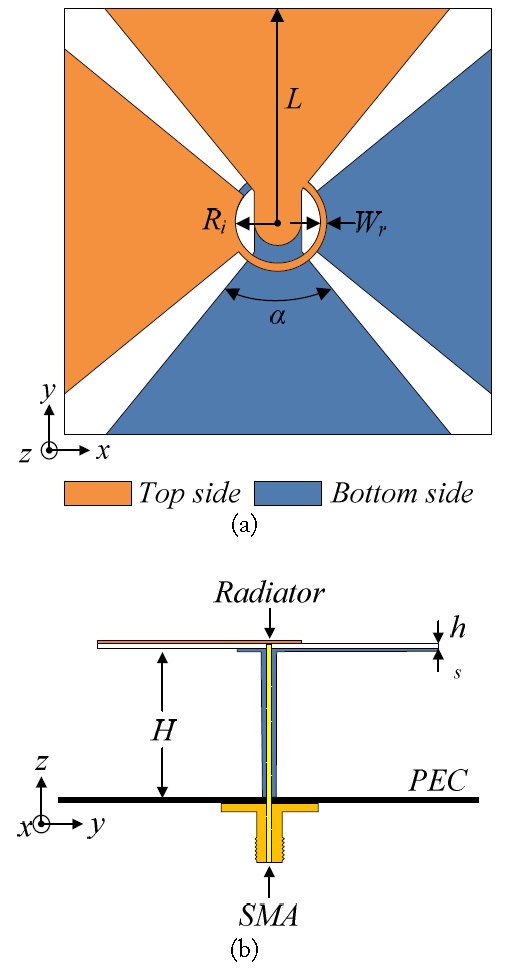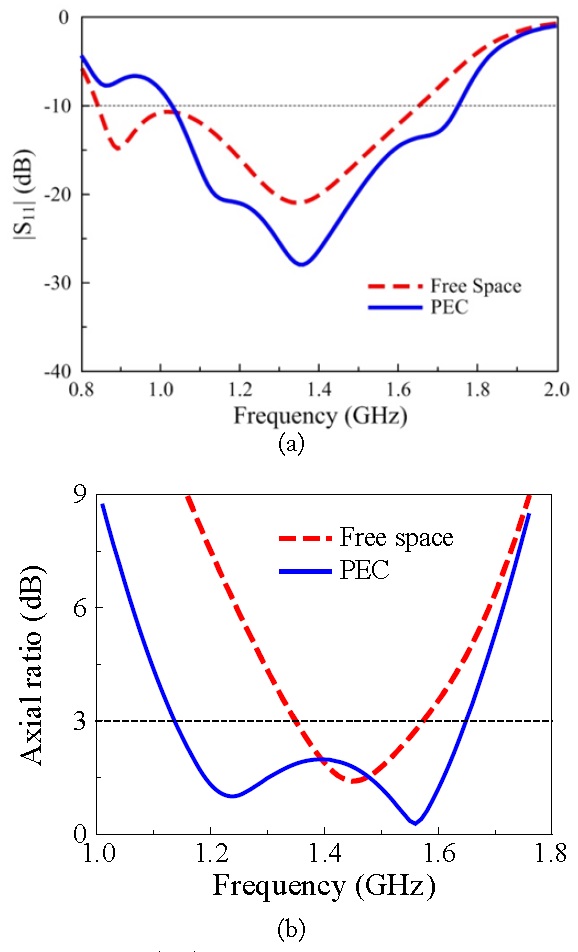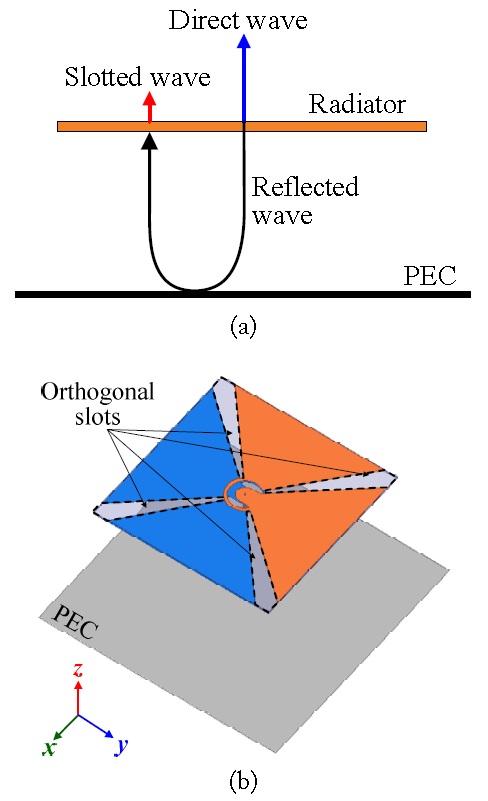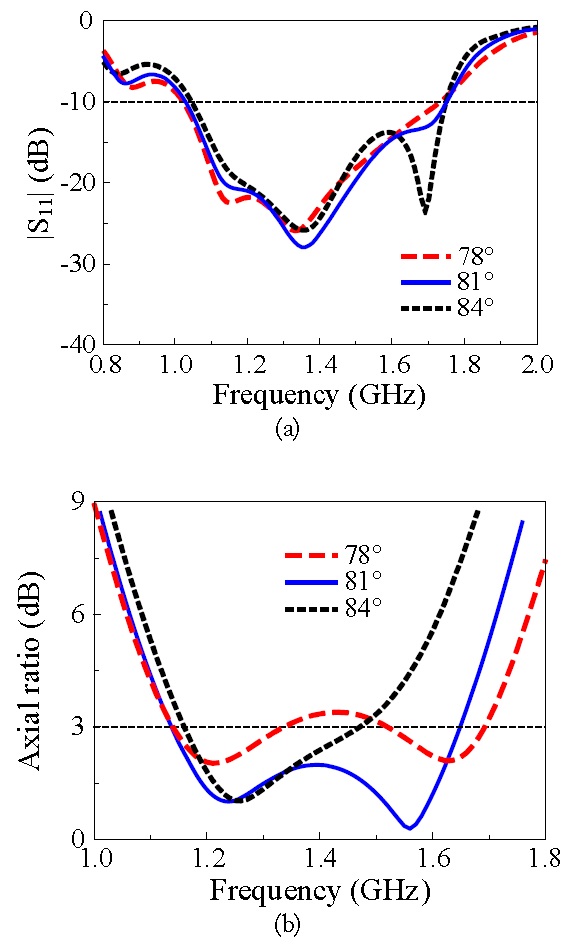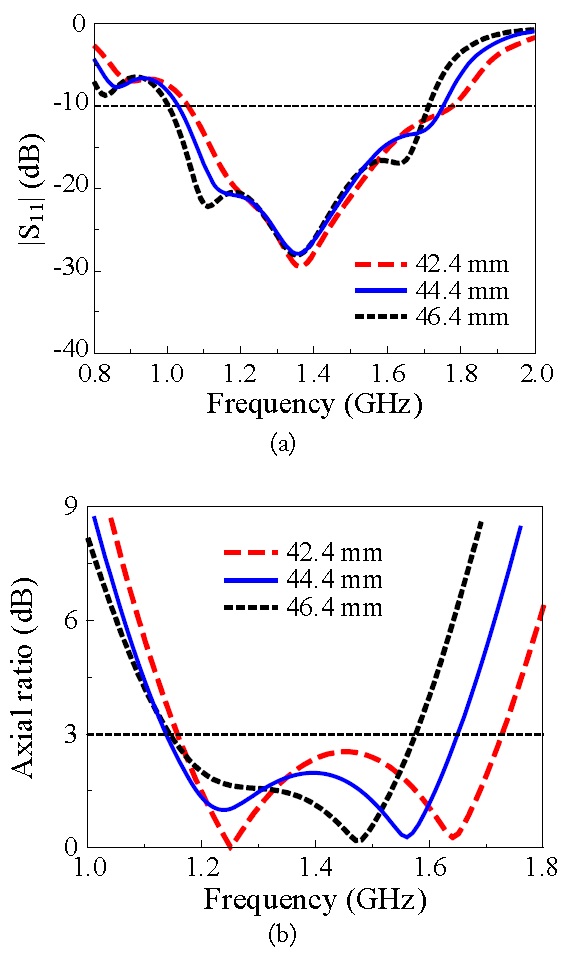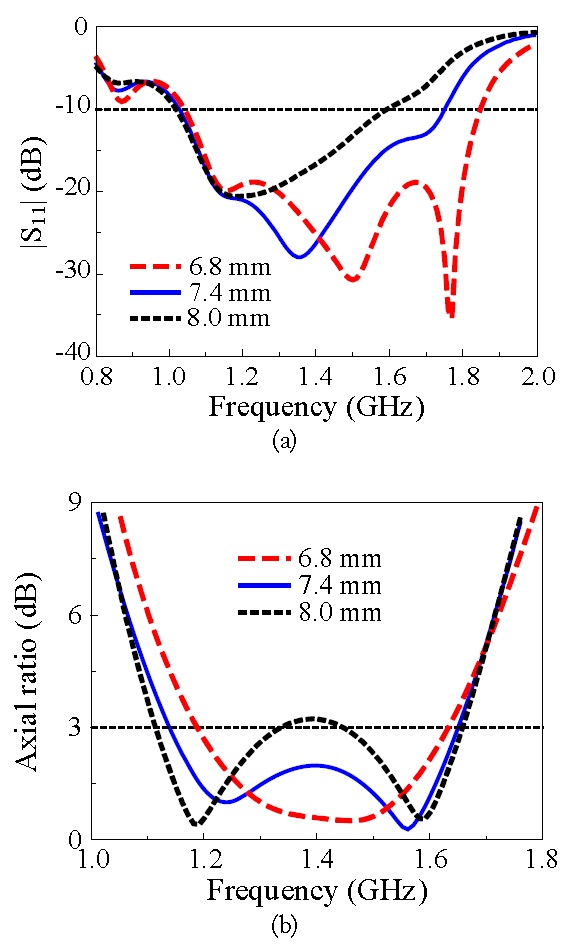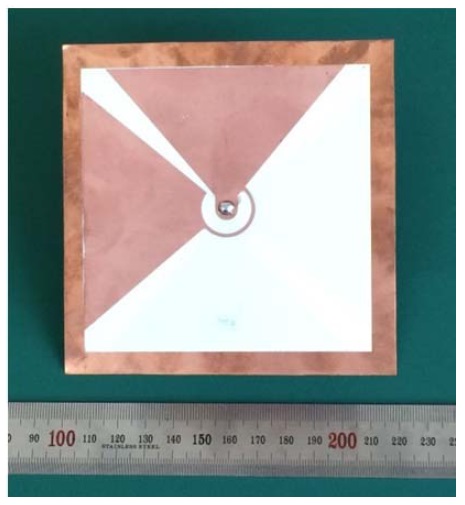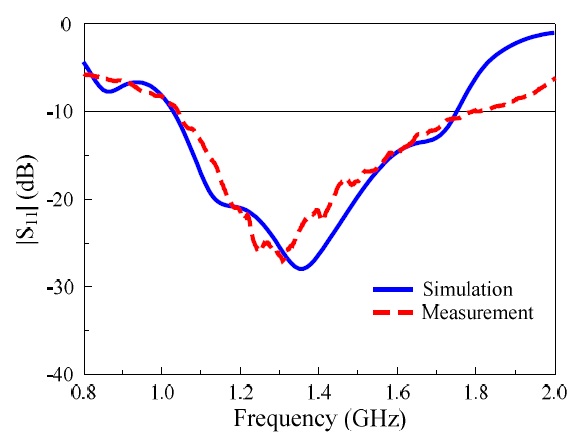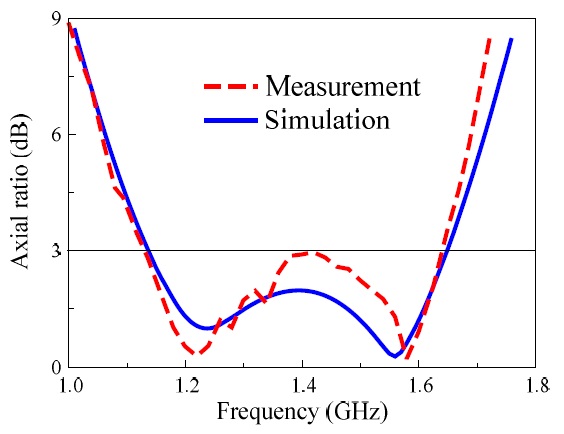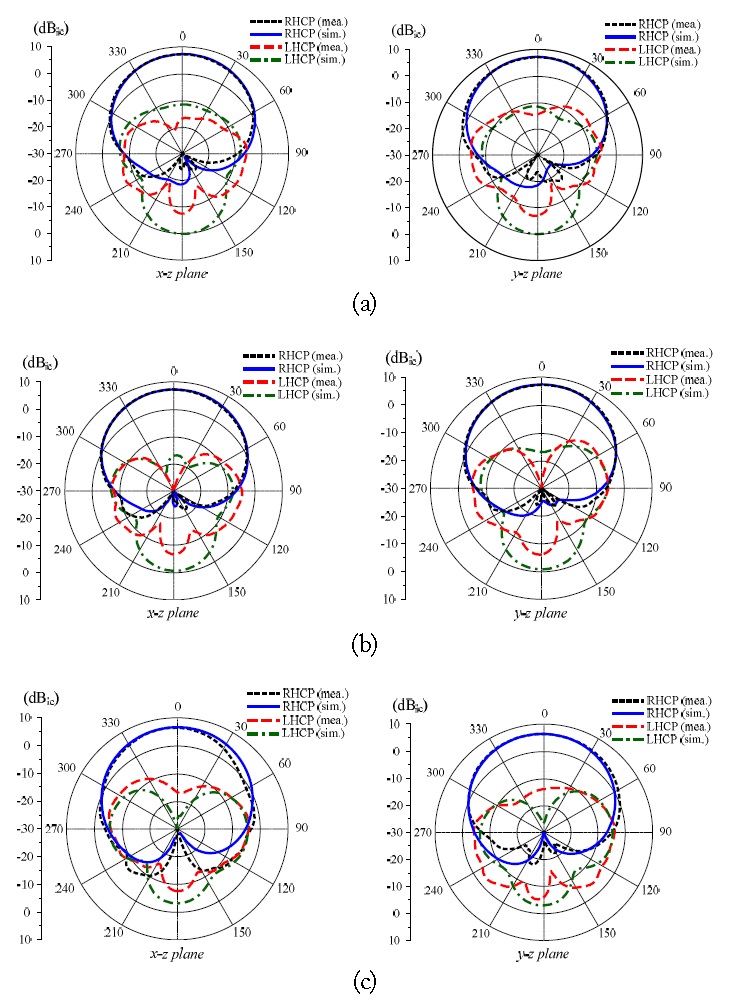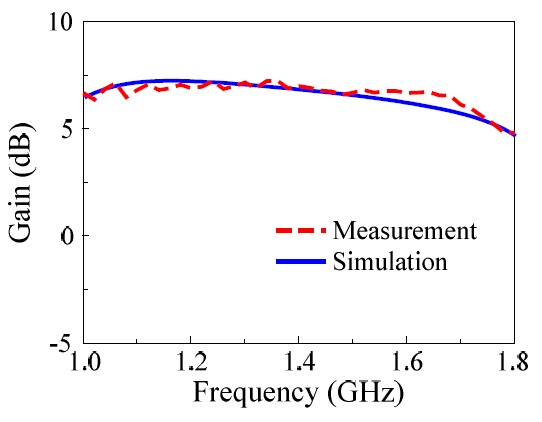



wideband circularly polarized (CP) antenna with a single feed is proposed for use in global navigation satellite systems. Its primary radiation elements are composed of two orthogonal bowtie dipoles, which are equipped with double-printed vacant-quarter rings to allow direct matching of the antenna to a single 50-Ω coaxial line and to produce CP radiation. The crossed bowtie dipole is appropriately incorporated with a planar metallic reflector to produce the desired unidirectional radiation pattern as well as to achieve a wideband characteristic in terms of impedance matching and axial ratio (AR) bandwidths. The designed antenna was fabricated and measured. The prototype antenna with an overall 1.2-GHz frequency size of 0.48 λo×0.48 λo×0.25 λo produced a measured |S11|<-10 dB bandwidth of 1.05-1.79 GHz and a measured 3-dB AR bandwidth of 1.12-1.64 GHz. It also showed right-hand CP radiation with a small gain variation (±0.3 dB) and high radiation efficiency (>93%) over the operational bandwidth.
Different services provided by satellite navigation systems have proliferated globally in the military arena as well as in the commercial and consumer markets. Four global navigation satellite systems (GNSSs) currently exist in the world-global positioning system (GPS), GLObal NAvigation Satellite System (GLONASS), Galileo, and Compass. Accordingly, antennas for GNSS applications have attracted considerable attention. An antenna for a GNSS receiver requires broadband characteristics fully covering the 1.146-1.616 GHz band, right-hand circularly polarized (RHCP) radiation with a wide beamwidth, and a high front-to-back ratio [1]. The current literature describes many broadband CP antennas for GNSS applications [2-7], where the CP radiation is realized in a broad frequency range by using several power combiners/splitters and phase shifters in the feeding network for these antennas. Unfortunately, this generally complicates the antenna design and fabrication.
In 1961, Bolster demonstrated that single-feed crossed dipoles connected in parallel can be generated CP radiation [8]. The required power and phase relationships are obtained by the proper choice of the lengths of the two dipoles [8].
This approach has been used to investigate single-feed composite cavity-backed crossed dipole antennas with a wide-beam CP radiation for GNSS applications [9-12]. Their operational bandwidths, however, do not fully cover the GNSS spectra. Recently, alternative engineering approaches have been taken for the single-feed crossed dipole antenna in order to broaden the operating bandwidth; a crossed dipole incorporated with parasitic loop resonators has achieved an impedance matching bandwidth of 1.9-2.9 GHz and an axial ratio (AR) bandwidth of 2.25-3.0 GHz [13]. A crossed dipole was designed with wide open ends for an impedance matching bandwidth of 1.99-3.22 GHz and an AR bandwidth of 2.30-2.90 GHz [14]. A modified magneto-electric dipole antenna with an overall size of 160×160×42 mm3 has enlarged the impedance matching bandwidth to 1.32-2.85 GHz and the 3-dB AR bandwidth to 1.69-2.75 GHz [15].
This paper presents a single-feed CP crossed bowtie dipole antenna with a wideband characteristic; its matching impedance bandwidth for |
Fig. 1 shows the geometry of the proposed antenna, which is composed of a radiator, a coaxial line, and a planar metallic reflector. The primary radiation element consists of two spatial orthogonal bowtie dipoles, which are designed on both sides of a 90×90 mm2 Rogers RO4003 substrate with a relative permittivity of 3.38, a loss tangent of 0.0027, and a thickness of 0.8128 mm. A pair of vacant-quarter printed rings is used as a feeding network and enables direct matching of the antenna to a single 50-Ω coaxial line and excitation of CP waves in the broadside direction. The outer wall of the coaxial cable is connected to the reflector and the bottom layer. A small hole is pierced into the bottom layer; the hole diameter is larger than that of the inner conductor to guarantee the separation between the bottom layer and the inner conductor. Finally, the inner conductor is connected to the top layer. The crossed bowtie dipoles are suspended at a distance
For the initial purpose, the crossed bowtie dipole radiator was backed by a metallic reflector (perfect electric conductor [PEC]) to redirect one-half of the radiating wave to the opposite direction, and consequently, to improve the antenna gain and partially shield the object on the other side. More interestingly, the presence of the reflector significantly broadens the 3-dB AR bandwidth of the antenna. This is evident in Fig. 2, which shows a comparison of |
This can be better understood by giving an explanation of the CP mechanism. The CP is achieved by using the approach reported in [8]; two dipoles with different lengths are chosen appropriately such that the real parts of their input admittances are equal and the phase angles of their input admittances differ by 90º. Accordingly, these conditions are obtained in the proposed antenna by using the vacant-quarter printed rings that made the dipoles slightly different lengths. Therefore, the antenna produces two resonances that perform a 90º phase differrence around desired frequency. The free space case clearly has two resonances at 0.9 and 1.35 GHz in the |
Due to the presence of the planar metallic reflector, the radiated wave includes the direct wave from the radiator and the reflected wave from the ground plane, as shown in Fig. 3(a). The direct wave radiates from the radiator directly and the conditions for the CP radiation were obtained by double vacantquarter printed rings [9]. The reflected wave incorporated with the chosen slots between the adjacent bowtie arms (Fig. 3(b)) generates the additional resonances and the additional CP radiation for the antenna system. These phenomena can be favorably used to improve the antenna performance, as demonstrated in Fig. 2. The phasing feed for the CP radiation of the slot antenna was obtained by an appropriate combination of the slot shape and the printed rings. The proposed antenna is therefore a suitable combination of a crossed dipole and an orthogonal slot antenna. The antenna worked as a crossed dipole in the low frequency region, whereas it behaved as a slot antenna in the high frequency region. Accordingly, the lower CP center frequency (1.23 GHz) was generated by the crossed dipole, whereas the higher one (1.57 GHz) was generated by the slot antenna. This is confirmed by the effects of the slot shapes on the antenna performances, as shown in Figs. 4 and 5. Fig. 4 shows the simulated |
As previously noted, the CP radiation was decided by the printed rings at both operation modes, the crossed dipole and the cross slot aperture antenna. This is demonstrated in Fig. 6, which shows simulated |
The proposed antenna was fabricated and measured. The crossed bowtie dipoles were built on both sides of a Rogers RO-4003 substrate with a copper thickness of 17 μm using standard wet-etching technology. The reflector was a square 0.5-mm thick copper plate. An SMA connector was used at the input port to feed the radiator. An Agilent N5230A network analyzer and a 3.5-mm coaxial calibration standard GCS35M were used for the input impedance measurement of the prototype, as shown in Fig. 7. Another Agilent E8362B network analyzer and a full anechoic chamber with the dimensions 15.2 m (
Fig. 8 presents a comparison of the measured and simulated reflection coefficients for the proposed antenna. The measured impedance bandwidth for |
The radiation patterns of the antenna at the center frequencies of the
A single-feed CP antenna with wideband characteristics was presented. The antenna, with an overall 1.2-GHz frequency size of 0.48 λo×0.48 λo×0.25
